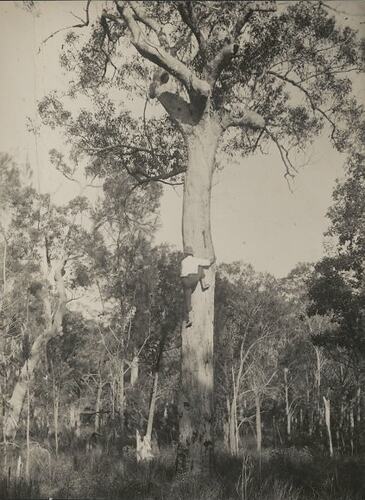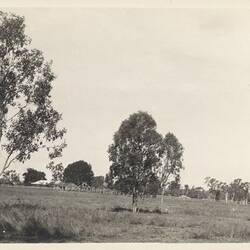'Anyone who can cast his or her mind back to the campout held at Byfield, Central Queensland in 1924, will recall that the veteran birdman, acting on request, threw off his boots and socks and, aided by a tomahawk, climbed sturdy trees without difficulty' (Chisholm, 1967).
Early life
Growing up in a family with strong connections to natural sciences, particularly in Entomology and Ornithology, it is no wonder that Henry Greensill Barnard become a zoologist, naturalist and grazier in his lifetime. Henry Barnard was born on 11 April 1869, at Crescent Lagoon, Rockhampton district, Queensland and died at the age of 97 on Friday 7 October 1966. Henry had seven brothers and sisters, of whom four were active naturalists.
The family estate at Coomooboolaroo in central western Queensland was often visited by naturalists and zoologists from around the world. Henry's father, George Barnard, had a collection of southern hemisphere insects (moths, butterflies and beetles) and bird eggs so vast that he had to build a mini museum on the Coomooboolaroo station to house them all. A Norwegian zoologist named Carl Lumholtz, described Henry and his brothers in 1889 as:
'The most skilful collectors I have ever met. They climbed the trees as easily as any black man. When they had their tomahawks in hand no tree was too high for them. They cut niches in the bark for the support of their toes. They were always barefooted in order to get about more easily. their keen faculty for observation astonished me again and again. They studied the life and habits of animals and gave me much valuable information, for they knew the fauna of the locality perfectly' (Robin, 2001).
From a very early age, Henry's father trained his boys in collecting. He would often send them out to collect a skin for every bird's egg they had. The skins they collected were sent to Dr E. P. Ramsay, Director of the Australian Museum in Sydney, for identification. Henry inherited a love of birds and, until his hearing and eyesight failed him in his 80s, he would often carry out his father wish for their protection by destroying snakes and goannas, feeding them and providing a place for them to live. As Henry remarks:
'We had a large garden at the station, and every afternoon, at four o'clock, a tin rattled and in a few minutes numbers of pigeons, doves, and quail were feeding on wheat scattered on the path in front of the verandah. There was a large lagoon near the homestead and no one was allowed to fire a gun near it, so there were always large numbers of waterfowl there. The lagoon was covered with blue water-lilies and never went dry' (Barnard, 1986).
Collecting in Australia
When he was just 19, Henry joined the expedition team led by Archie Meston, who discovered the first specimen of an adult male Golden Bowerbird, Prionodura newtoniana. Despite working on the family station at Coomooboolaroo and eventually his own, Bimbi, near Duaringa for most of his life, Henry also went on many expeditions. In 1894 he visited the Ferguson Island, the Trobriands and Woodlark off the east coast of New Guinea and in 1896, Port Darwin and Cape York. He collected specimens at Cape York for H.L. White in 1899 and from 1910 -1911.
Henry married Alice Maud Mary Elworthy on 22 November 1899. They had eight children who Alice cared for on her own during Henry's collecting expeditions.
Nineteenth century ornithology relied on enthusiastic individuals who were happy to brave the elements to make even the smallest contribution to science. Such individuals, including Henry Barnard, also relied on the good will of their patrons. As well as collecting for H.L White, over the course of his career Henry collected for Museums and private collectors such as Lord Rothschild of the Tring Museum in England, the Australian Museum in Sydney, (Sir) Charles Ryan, William Snowball, William Henry Dudley Le Souef and many others. The now famous H.L White bird collection at the Museum of Victoria, Melbourne, prominently features Henry's contributions.
The drought of 1927 greatly affected the bird populations in Queensland. Henry lamented this in his article 'Effects of Droughts on Bird-Life in Central Queensland', published in Emu, the journal for the Royal Australasian Ornithologists' Union (R.A.O.U), in 1927. His works featured in the Queensland Naturalist and his published observations have been listed in H. M. Whittell's The Literature of Australian Birds.
Henry joined the R.A.O.U in 1901 and through R.A.O.U's archives and the specimens in H.L. White's bird collection, Henry Barnard's contribution to Ornithology in Australia lives on.
Related Information
H.L. White Collection of Australian Birds' Eggs
References
Barnard, H.G. (1986). Why I became interested in natural history. La Trobe Library Journal, 10(38): 33-34
Chisholm A.H. (1967). Obituary: H.G. Barnard. (1869-1966). Emu, 66(4): 391 - 393.
Family Notices. (1899, December 2). The Queenslander (Brisbane, Qld: 1866 - 1939), p. 1084. Retrieved April 28, 2015, from http://nla.gov.au/nla.news-article22562908
Geoff Bell. (2014). Henry Greensill BARNARD (1869 - 1966). Retrieved from http://www.bellsite.id.au/gdbtree/HTMLFiles/HTMLFiles_36/P1757.html
Glen Ingram, 'Barnard, Henry Greensill (Harry) (1869-1966)', Australian Dictionary of Biography, National Centre of Biography, Australian National University, http://adb.anu.edu.au/biography/barnard-henry-greensill-harry-9435/text16587, published first in hardcopy 1993, accessed online 28 April 2015.
McCarthy, G.J. (1993). Barnard, George (1830 - 1894). Retrieved from http://www.eoas.info/bib/ASBS02149.htm
QUEENSLAND DROUGHT. (1927, June 10). Barrier Miner (Broken Hill, NSW: 1888 - 1954), p. 1. Retrieved May 26, 2015, from http://nla.gov.au/nla.news-article46002577
Robin, Libby. (2001). The Flight of the Emu: A Hundred Years of the Australian Ornithology. Melbourne: Melbourne University Press.
More Information
-
Keywords
-
Authors
-
Article types



